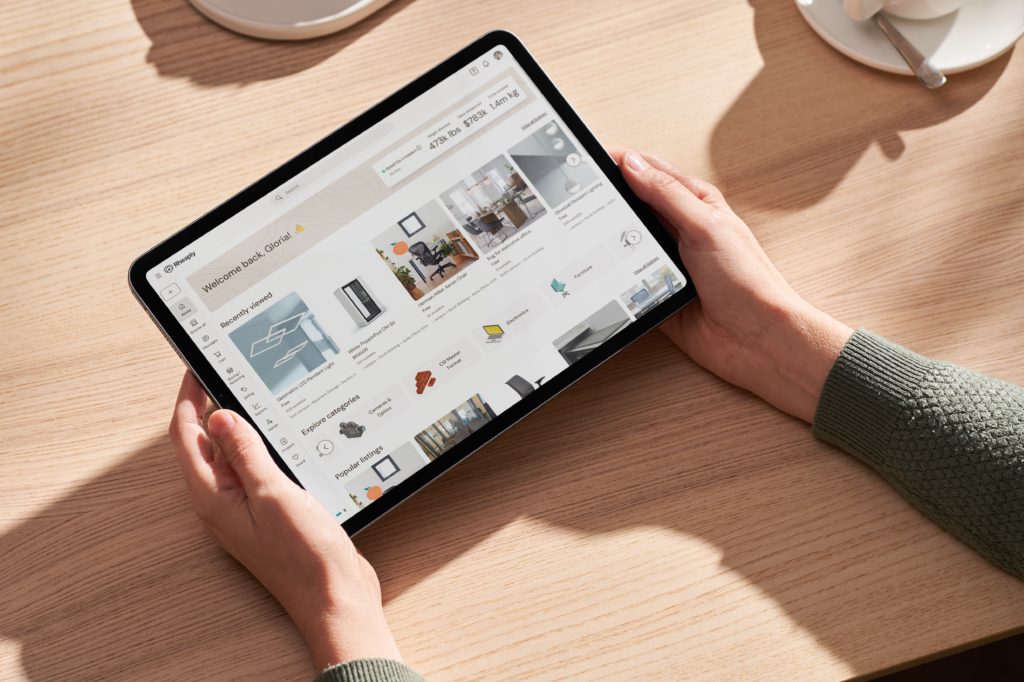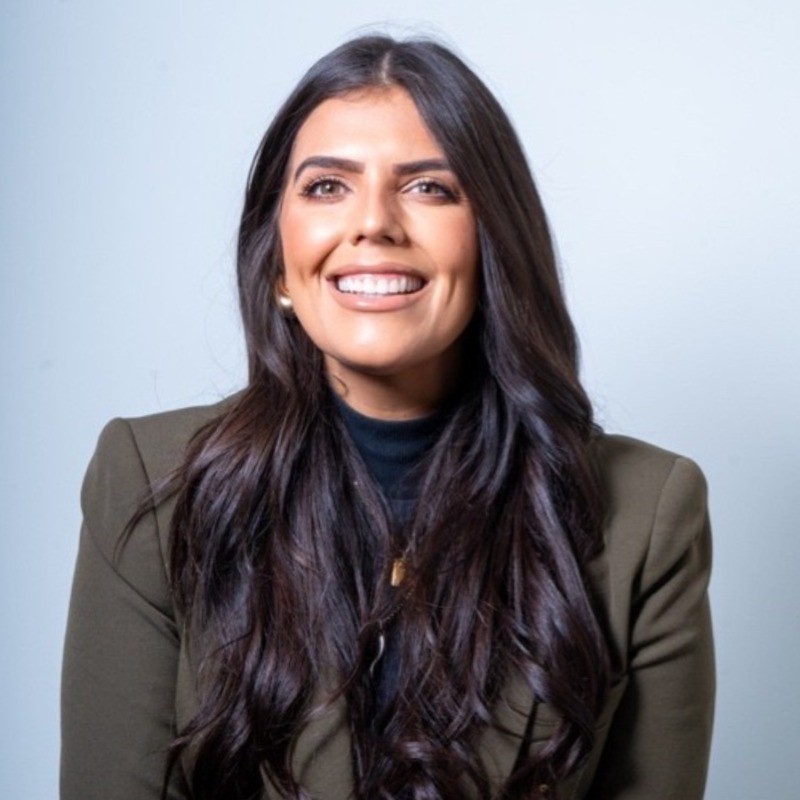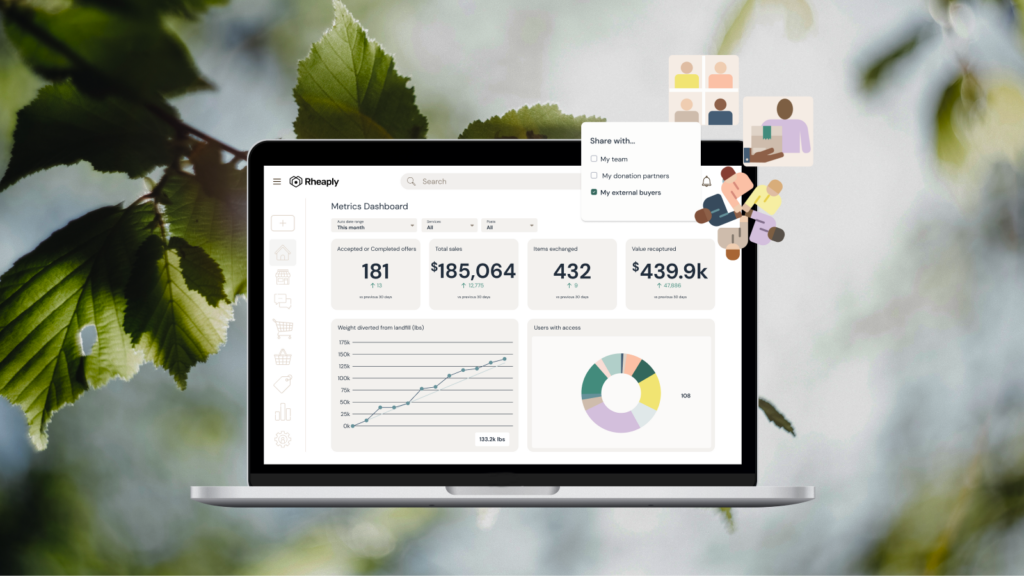
Here at Rheaply HQ, we’ve been noticing a lot of momentum behind Next Life, our combined product and services offering that helps facilities and real estate teams achieve sustainable disposition by selling or donating unneeded workplace assets. Next Life helps stop overspending on storage and waste hauling and keep valuable items out of the landfill by choosing their “next life” with a local business or nonprofit.
Inspiring, right?
To spread the word on all the good work Rheaply Next Life has enabled, we chatted with Emma Hopson, our Senior Sustainability Manager. Through her work with decommissions and relationships with players in the Rheaply Ecosystem, Emma has had a front seat look into how organizations implement sustainable disposition by selling and donating their idle assets.
So, what is Rheaply Next Life?
Rheaply Next Life is the opportunity for organizations to invest in themselves and invest in their communities by putting their idle assets to good use through sustainable disposition.
When choosing the next life for your assets, that means you’re choosing if you want to sell or if you want to donate. But either choice means you’re circulating resources in your local community and planning for a better, more sustainable future when it comes to how we treat our “stuff.”

How do you think Next Life aligns with Rheaply’s mission and vision?
I think it’s a perfect alignment with our mission and what we’ve set out to do, to ensure that every workplace finds its next best use. One way we do that is through Circulate, which helps companies share and exchange assets internally to reduce procurement costs and boost sustainability. But what about idle assets you no longer need? That’s where Next Life comes in. We are taking assets that are sitting idle and finding their absolute next, best use. It doesn’t get more aligned than that.
At the end of the day, Rheaply cares about our communities and the environment. Many of our Next Life clients share these values as well by choosing to invest in their local communities by way of these donations.
What have been some of your favorite
Next Life customer success stories?
There are so, so many, but I’ll share two.
Earlier this year, we had a major, big box retail client who had a lot of leftover fixtures and equipment from a closed store. They wanted to sell as much as possible to recover the asset value.
What can you do with loads of mannequins, clothing racks, storage shelves, and steel barricades?
For the steel barricades in particular, we were able to find a buyer who would give them a new home at a nightclub! These old steel barricades went from an everyday retail store to a very exciting “next life” at a local nightclub, and our retail client got some of their money back in the process.
The other example comes from a major tech company we work with in San Francisco. They had several hundred pieces of office furniture—things like couches, chairs, tables, bookshelves—that they no longer needed; and meanwhile we had a nonprofit partner in LA focused on providing housing to low-income families and Veterans. The nonprofit had the structures, but nothing to furnish for their clients.
We were able to team up with one of our clients’ partners, Interface, to deliver all the surplus furniture from San Francisco to Los Angeles to help furnish these apartments for low-income families and veterans.
What I love about that story is that it just highlights so beautifully the importance of partnerships to enable a circular economy and how everyone’s role matters.
What is the value for facilities and workplace design teams to plan ahead for the Next Life of their assets?
The value is threefold:
- They can actually see what surplus they have
- They free up space and save money on storage
- They drive meaningful impact when they pass their idle assets forward
Oftentimes, organizations think to themselves, “I have a room full of stuff, but no one’s going to want that.” In reality, what is old or undesirable to them is considered brand new and incredibly valuable to organizations that don’t have the budgets to pay for new furniture – like so many of the nonprofits in our ecosystem.
I think about one of our projects with a major banking client in New York. They were looking to donate a floor full of high quality Steelcase Amia task chairs that were from 2009. The chairs were a little bit dinged up, but otherwise were in perfect working condition.
When I showed the listing to our contact at a local university and medical center, they said, “These are available for donation? Wow, our nurses have been sitting on the same chairs since the ’70s. They would love these, can we really have these?”
Rheaply Next Life allows our partners and nonprofits to be able to spend their precious, limited budgets on people, on programs, and on initiatives, instead of just “stuff.”
What have you seen as the biggest challenge customers are facing before they implement Next Life?
So many customers have no idea what they actually have.
They know that there is some storage space with a lot of assets, and they may know some specifics about it, but they don’t have that full overview. That means they don’t understand the impact they could make until they leverage Next Life.
We solve that for customers by implementing on-site digitization with the purchase of Circulate and Next Life. We’ll come on site to that location and help you digitize all of those assets in that storage room and input data for clients.
Rheaply makes it super easy to accurately estimate product sustainability data like weight and embodied carbon, and financial information like replacement cost and market value. The value aspect is important because if they’re going to sell those items, it helps us assess the market and/or donation value based on the condition of those assets for sustainable disposition.

What do you think makes Next Life stand out compared to other donation or auction services?
Many organizations set up donations but they find themselves stuck in an endless loop of emails and phone calls to coordinate for each donation, making the process really inefficient and frustrating. With Rheaply’s centralized platform, they can upload their assets, send a link to their chosen nonprofits, and handle all communication in one place.
The sustainability teams that are working so hard to measure these donations on their own get instant impact reporting on the waste diverted from the landfill. It allows for them to get the credit they deserve from all of their hard work and tell an amazing story, while also streamlining their processes.
Another thing that I really admire about our platform is the approach that we take with nonprofit partners.
Nonprofit partners will say that they’ll get a call for donations, and oftentimes the donating organization will just come and drop off all of the items on their doorstep. But our platform is a two-way street where the nonprofits can shop from free materials and have the power to choose what they want.
It’s really special that we put them in the driver’s seat of their own donations, and for our enterprise clients, that means their old assets are going somewhere they will actually be used, appreciated, and cherished.
It’s a win-win scenario for everybody.
What should people do if they want to learn more about Next Life?
You’ve got a few options! You can fill out this form on our website to request a demo conversation with someone on our sales team to learn more about your specific needs. Or you can watch this on-demand webinar recording where my teammate Lily shows how we facilitate sales and donations with Rheaply Next Life. Or finally you can reach out to me on LinkedIn and I’d be happy to chat with you personally—I love talking to people about this stuff!
